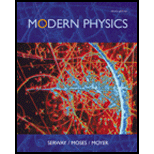
Concept explainers
(a)
The show that the reflected wave has frequency of
(a)
Answer to Problem 18P
The reflected wave has frequency of
Explanation of Solution
Write the expression for the frequency as seen by the car.
Here,
Write the expression for the frequency of the reflected wave.
Here,
Conclusion:
Use
Therefore, the reflected wave has frequency of
(b)
The show that the beat frequency can be written as
(b)
Answer to Problem 18P
The beat frequency can be written as
Explanation of Solution
Use the expression for the frequency obtained in (a) and simplify.
The expression for the beat frequency is,
Use
Conclusion:
Therefore, the beat frequency can be written as
(c)
The beat frequency measured for a car speed of 30.0 m/s if the microwaves have frequency 10.0 GHz.
(c)
Answer to Problem 18P
The beat frequency measured for a car speed of 30.0 m/s if the microwaves have frequency 10.0 GHz is
Explanation of Solution
Rewrite the expression for beat frequency
Use
Conclusion:
Substitute
Therefore, the beat frequency measured for a car speed of 30.0 m/s if the microwaves have frequency 10.0 GHz is
(d)
If the beat frequency measured is accurate to
(d)
Answer to Problem 18P
The velocity measured is accurate to
Explanation of Solution
The expression for change beat frequency is,
Rearrange in terms of v.
Conclusion:
Substitute
Therefore, the velocity measured is accurate to
Want to see more full solutions like this?
Chapter 1 Solutions
Modern Physics
- Pls help ASAParrow_forward14. A boy is out walking his dog. From his house, he walks 30 m North, then 23 m East, then 120 cm South, then 95 m West, and finally 10 m East. Draw a diagram showing the path that the boy walked, his total displacement, and then determine the magnitude and direction of his total displacement.arrow_forwardPls help ASAParrow_forward
- 12. A motorboat traveling 6 m/s, West encounters a water current travelling 3.5 m/s, South. a) Draw a vector diagram showing the resultant velocity, then determine the resultant velocity of the motorboat. b) If the width of the river is 112 m wide, then how much time does it take for the boat to travel shore to shore? c) What distance downstream does the boat reach the opposite shore?arrow_forwardLake Erie contains roughly 4.00⋅10114.00⋅1011 m3 of water. Assume the density of this water is 1000. kg/m3 and the specific heat of water is 4186 J/kg˚C. It takes 2.31x10^19 J of energy to raise the temperature of that volume of water from 12.0 °C to 25.8 ˚C. An electric power plant can produce about 1110 MW. How many years would it take to supply this amount of energy by using the 1110 MW from an electric power plant?arrow_forwardPls help ASAParrow_forward
- Pls help ASAParrow_forwardm m $2° 15. A truck is stopped at a red light. Once the light turns green, the truck accelerates forward at 1.75- that same instant, a car moving with a constant speed of 50 — passes the truck. a) How many seconds will it take for the truck to catch up to the car? S b) How many metres will the truck travel before it catches up to the car? Atarrow_forwardPls help ASAParrow_forward
 Principles of Physics: A Calculus-Based TextPhysicsISBN:9781133104261Author:Raymond A. Serway, John W. JewettPublisher:Cengage Learning
Principles of Physics: A Calculus-Based TextPhysicsISBN:9781133104261Author:Raymond A. Serway, John W. JewettPublisher:Cengage Learning College PhysicsPhysicsISBN:9781938168000Author:Paul Peter Urone, Roger HinrichsPublisher:OpenStax College
College PhysicsPhysicsISBN:9781938168000Author:Paul Peter Urone, Roger HinrichsPublisher:OpenStax College Physics for Scientists and Engineers: Foundations...PhysicsISBN:9781133939146Author:Katz, Debora M.Publisher:Cengage Learning
Physics for Scientists and Engineers: Foundations...PhysicsISBN:9781133939146Author:Katz, Debora M.Publisher:Cengage Learning Modern PhysicsPhysicsISBN:9781111794378Author:Raymond A. Serway, Clement J. Moses, Curt A. MoyerPublisher:Cengage Learning
Modern PhysicsPhysicsISBN:9781111794378Author:Raymond A. Serway, Clement J. Moses, Curt A. MoyerPublisher:Cengage Learning University Physics Volume 3PhysicsISBN:9781938168185Author:William Moebs, Jeff SannyPublisher:OpenStax
University Physics Volume 3PhysicsISBN:9781938168185Author:William Moebs, Jeff SannyPublisher:OpenStax Physics for Scientists and Engineers with Modern ...PhysicsISBN:9781337553292Author:Raymond A. Serway, John W. JewettPublisher:Cengage Learning
Physics for Scientists and Engineers with Modern ...PhysicsISBN:9781337553292Author:Raymond A. Serway, John W. JewettPublisher:Cengage Learning





